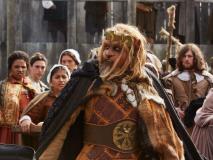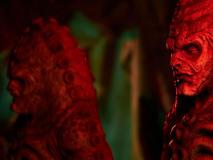The Artwork of Jeff Cummins and Colin Howard
Jeff Cummins has been a prolific artist on many book covers, album covers, and posters since 1976. He is well-known for his work on the Target novelisations of the 1970s/1980s, most notably The Face of Evil, The Three Doctors and Horror of Fang Rock, as well as cover art for several of the New Adventures of the 1990s, including the seminal Dimension Riders and Conundrum. His cover work for Doctor Who helped redefine the look of Target books, expanding the canvas begun by Chris Achilléos.
Head of Publishing, Shaun Russell said:
Born, educated and art-schooled in Flintshire, North Wales, Jeff Cummins moved to London in 1974 and while working a graphic designer there, he freelanced and painted posters for Bruce Lee, covers for Kung Fu Monthly, Doctor Who and The Six Million Dollar Man for TV Sci-Fi Magazine. However, with many recognising his work but unaware he was the artist, he often thought of himself invisible, hence this volume entitled The Invisible Artist!
Jeff said:
A long-time fan of the Target range, in particular the work Jeff did, the book is edited by Andy Frankham-Allen,
who said:
Jeff added:
My Target experience overall was happy, intense, but satisfying. Although I only ever see faults in my work, the generous feedback I’ve received over the years is very humbling. I’m very proud of my association with Doctor Who and my small contribution to its history.
As well as his Doctor Who work, the book also discusses The Beatles, of Paul McCartney and his wife, Linda, how Jeff was involved in the marketing of the blockbuster film Back to the Future, painting such artists of Eric Clapton, Ozo, Blondie, David Essex… and so many more. If a pop/rock artist was popular in the late’70s/early-80s, the chances are you’ll find them in The Invisible Artist.
While most fans will know Colin Howard best for illustrating some thirty VHS covers in the 1990s, his Doctor Who portfolio further includes a vast amount of highly-detailed paintings for Doctor Who Magazine, the BBC Books ranges, private commissions, the Lethbridge-Stewart novels, calendars, posters, Doctor Who Classic Comics, and the recent DVD and Blu-ray range of animations for missing episodes like The Macra Terror, Shada, and The Evil of the Daleks. Timeslides explores this incredible body of work, with each piece accompanied by a fascinating commentary from Colin.
Shaun Russell enthused:
Colin Howard said:
I was really keen to open up my portfolio and see what fell out. We had a few disasters – I'd saved much of my original art and accompanying sketches, as well as the final products they were used on, but some of that was lost thanks to a leak in the roof!
Fortunately, the main victims were the replaceable bits: we managed to salvage all the originals, and we've worked hard to reproduce them in a high-quality that even the BBC struggled to print back in the day.
Timeslides (which takes its name from an episode of Colin's beloved Red Dwarf) is edited by Philip Bates, author of 100 Objects of Doctor Who. He said:
When Shaun told me Candy Jar would be working with Colin on a book of his Doctor Who art, I cleared a space on my bookshelf next to Kklak! I was eager to get my hands on a copy. Little did I realise that Shaun was actually asking me to edit it.
I grew up in the so-called ‘Wilderness Years’, and those gorgeous VHS covers were my introduction to Doctor Who in other mediums, probably before I was aware of the Target novels properly. So the videos hold a special place in my heart, and I know that’s true for so many other fans too. Naturally, I was super excited at the idea of getting to know Colin, let alone riffle through his archive – much of which many Doctor Who fans have never seen before. It’s an absolute privilege.
In this unique glimpse inside the artist’s studio, Colin chats about his artistic inspirations and aspirations, which aspects of Doctor Who really capture his imagination, which works he’s especially proud of, his real-life adventures at a cheetah rehabilitation centre in South Africa, and much more.Philip explained how difficult it’s been narrowing down what actually made it into Timeslides:
One of the main challenges has been deciding on the shortlist, such is the wealth of artwork in his collection. I thought I knew Colin’s portfolio well, but I was shocked to learn just how much more he’s done. The VHS covers were essential. But how do you decide which other masterpieces make the cut? I gravitate towards artworks with great stories behind them… but talking with Colin, it became clear that that’s true of all his paintings. I mean, he's got his very own ‘missing Doctor Who story’ – one of his pieces was lost in transit and has been MIA for over twenty-five years!
But I'm really happy with the final selection and I think fans will love it too. It feels representative of Col's overall artistic journey, and delivers what readers expect, but there are also some great little surprises along the way too.
Colin concluded:























